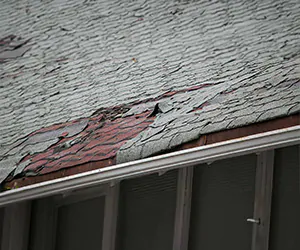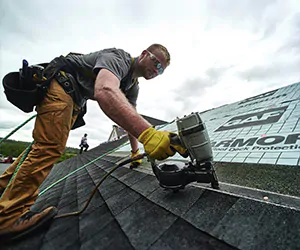Posted in:

In this article, I will explain how to know when it’s time for a new roof, what factors to consider when replacing your roof, and how to choose the right materials for your home.
Signs of Roof Damage
The first step in knowing when it’s time for a new roof is to look for signs of damage. Some of the most common signs of roof damage include:
1. Shingle Damage
Shingles that are cracked, missing, or curling are a sign that your roof is nearing the end of its life. Damaged shingles can allow water to seep into your home, causing water damage and other issues.
2. Water Stains
Water stains on your ceiling or walls are a sign that your roof is leaking. This could be due to a damaged roof, missing shingles, or other issues.
3. Sagging Roof
A sagging roof is a sign that there is a problem with your roof’s structure. This could be due to water damage, rot, or other issues.
4. Granules in Gutters
If you notice granules in your gutters, it’s a sign that your shingles are wearing out. This could be due to age or damage.
When to Replace Your Roof
Once you have identified signs of damage, you then need to determine if it’s time to replace your roof. Some factors to consider include:
1. Age
Most roofs last between 15 and 25 years, depending on the materials used. If your roof is approaching the end of its lifespan, it’s likely time to replace it.
2. Damage
If your roof has sustained significant damage, it may need to be replaced. This could include damage from a storm, tree limbs, or other causes.
3. Energy Efficiency
If you are looking to improve your home’s energy efficiency, replacing your roof with more energy-efficient materials can help.
4. Aesthetics
If your roof is looking worn or outdated, replacing it can improve your home’s curb appeal.
The Roof Replacement Checklist
If you have determined that it’s time to replace your roof, there are several steps you should take to ensure the process goes smoothly:
1. Choose a Contractor
Choose a licensed and insured roofing contractor with a good reputation in your community. Look for a contractor who has experience with the type of roof you have and who uses high-quality materials.
2. Get a Quote
Get a written quote from your contractor that includes the cost of materials, labor, and any other fees.
3. Obtain Permits
Your contractor should obtain any necessary permits before starting work on your roof.
4. Remove Old Roof
Your contractor will remove your old roof, inspect the decking, and make any necessary repairs.
5. Install New Roof
Your contractor will install your new roof, ensuring that it’s properly ventilated and meets local building codes.
6. Clean Up
Your contractor will clean up any debris from the job site, leaving your property clean and tidy.
Choosing the Right Roofing Materials for Your Home
Choosing the right roofing materials for your home is essential for both aesthetics and functionality. Some of the most common roofing materials include:
1. Asphalt Shingles
Asphalt shingles are the most popular roofing material in the United States. They are affordable, durable, and come in a variety of colors and styles.
2. Metal Roofing
Metal roofing is long-lasting, energy-efficient, and can help reduce heating and cooling costs.
3. Clay or Concrete Tiles
Clay or concrete tiles are ideal for homes with a Mediterranean or Spanish-style design. They are long-lasting and come in a variety of colors and shapes.
4. Slate
Slate is a natural stone that is durable and long-lasting. It’s ideal for homes with a classic or traditional design.
Hiring a Professional Roofing Contractor

1. Experience
Choose a contractor with experience installing roofs similar to yours.
2. Reputation
Look for a contractor with a good reputation in your community.
3. Licensing and Insurance
Choose a contractor who is licensed and insured.
4. Warranty
Choose a contractor who offers a warranty on their work.
DIY vs. Professional Roof Replacement
While a DIY roof replacement may save you money, it’s not recommended for most homeowners. Roofing is a dangerous and complex task that requires specialized tools and knowledge. A professional contractor has the experience and tools necessary to ensure that your roof is installed correctly and safely.
The Cost of Replacing Your Roof
The cost of replacing your roof will depend on several factors, including the materials used, the size of your roof, and your location. It’s essential to budget for the cost of a new roof, as it can be a significant expense. However, a new roof can also add value to your home and improve its energy efficiency.
Roof Maintenance Tips
Once your new roof is installed, it is essential to take steps to extend its life. Some roof maintenance tips include:
1. Inspect Your Roof Regularly
Inspect your roof at least twice a year to identify any signs of damage.
2. Keep Gutters Clean
Clean your gutters regularly to prevent water damage to your roof and home.
3. Trim Trees
Trim any trees near your home to prevent damage to your roof from falling limbs.
4. Schedule Regular Maintenance
Schedule regular maintenance with your roofing contractor to ensure that your roof is in good condition.
Conclusion
Knowing when it is time to replace your roof is essential for the safety and well-being of your home and family. By identifying signs of damage, choosing the right materials, and hiring a professional contractor, you can ensure that your new roof is installed correctly and safely. Do not wait for a disaster to strike: take action now to replace your roof and protect your home.
Jun 09, 2023







